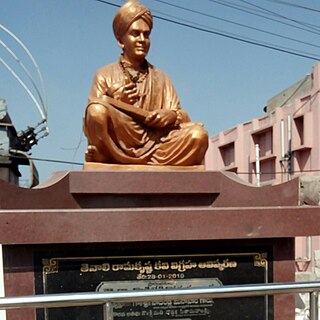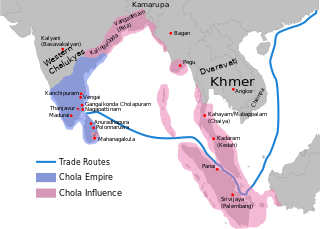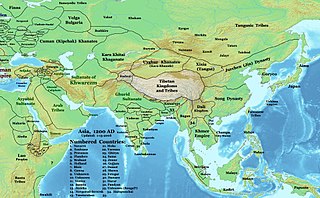Related Research Articles

Venkateswara, Venkatachalapati, Balaji, or Srinivasa, is a form of the Hindu deity Vishnu and is the presiding deity of the Venkateshwara Temple, located in Tirupati, Andhra Pradesh, India. Venkateshwara is also known by various other names. The deity is worshiped by North Indians by the name 'Balaji'.

Tenali Ramakrishnudu (Telugu: తెనాలి రామకృష్ణుడు, was a Telugu language poet, scholar, thinker and a special advisor in the court of the Vijayanagara king Krishnadevaraya, who ruled from 1509 to 1529 CE. He hailed from the village of Tenali and wrote poetry in Telugu. He is generally known for the folk tales which focus on his wit. He was one of the Ashtadiggajas, the eight poets in the court of Krishnadevaraya.

Krishnadevaraya was an emperor of the Vijayanagara Empire reigning from 1509 to 1529. He was the third monarch of the Tuluva dynasty, and is considered to be one of the greatest rulers in Indian history. He ruled the largest empire in India after the fall of the Islamic Delhi Sultanate. Presiding over the empire at its zenith, he is regarded as an icon by many Indians. Krishnadevaraya earned the titles Andhra Bhoja, Karnatakaratna Simhasanadeeshwara, Yavana Rajya Pratistapanacharya, Kannada Rajya Rama Ramana, Gaubrahmana Pratipalaka and Mooru Rayara Ganda. He became the dominant ruler of the peninsula by defeating the sultans of Bijapur, Golconda, the Bahmani Sultanate and the Gajapatis of Odisha, and was one of the most powerful Hindu rulers in India.

Uthamar Kovil in Uthamarkoil, a village in the outskirts of Tiruchirappalli in the South Indian state of Tamil Nadu, is dedicated to the Hindu Trimurti of Vishnu, Shiva, and Brahma. Constructed in the Dravidian style of architecture, the temple is glorified in the Nalayira Divya Prabandham, the early medieval Tamil canon of the Alvar saints from the 6th–9th centuries CE. It is one of the 108 Divya Desams dedicated to Vishnu, who is worshipped as Purushothaman Perumal and his consort Lakshmi as Poornavalli Thayar.
Mudaliar is a Tamil title and surname. As title, it was historically given to high-ranking officers, administrators and their descendants during the Chola empire rule. The surname is most prevalent among Tamils from Tamil Nadu and Sri Lanka. Descendants of Tamil colonial migrants also bears variants of the name in countries such as South Africa, and elsewhere in the Tamil diaspora.

The Kakatiya dynasty was an Indian dynasty that ruled most of eastern Deccan region in present-day India between 12th and 14th centuries. Their territory comprised much of the present day Telangana and Andhra Pradesh, and parts of eastern Karnataka, northern Tamil Nadu, and southern Odisha. Their capital was Orugallu, now known as Warangal.The Kakatiya rulers traced their ancestry to a legendary chief or ruler named Durjaya, a descendant of Karikala Chola.

The Chola dynasty was a Tamil dynasty originating from southern India. At its height, it ruled over the Chola Empire, an expansive maritime empire. The earliest datable references to the Chola are from inscriptions dated to the 3rd century BCE during the reign of Ashoka of the Maurya empire. The Chola empire was at its peak and achieved imperialism under the Medieval Cholas in the mid-9th century CE. As one of the Three Crowned Kings of Tamilakam, along with the Chera and Pandya, the dynasty continued to govern over varying territories until the 13th century CE.

Karikala often referred to as Karikala the Great was a Tamil Emperor of the Early Cholas of the Chola dynasty who ruled ancient Tamilakam from Uraiyur. He is credited with the construction of the flood banks of the river Kaveri and conquest of Tamilakam, Andhra and Sri Lanka. He is recognised as the greatest of the Early Cholas. In Thiruvalangadu plates of Rajendra Chola I, Medieval Tamil Cholas listed Karikala Chola as one of their ancestors.

The Early Cholas were a Tamil kingdom of the Chola dynasty - pre and post Sangam period. It was one of the three main kingdoms of Tamilakam. Their early capitals were Urayur or Tiruchirapalli and Kaveripattinam. Along with Pandyas and Cheras, Chola history goes back to the period when written records were scarce.

The Chola Empire, which is often referred to as the Imperial Cholas, was a medieval Indian, thalassocratic empire that was established by the Chola dynasty that rose to prominence during the middle of the ninth century and united southern India under their rule.

The Telugu Chodas or Telugu Cholas ruled parts of present-day Andhra Pradesh and Telangana between the 5th and the 13th centuries as samantas of Pallavas and later the Imperial Cholas. Various dynasties exist among them including Velanati, Pottapi, Konidena, Nannuru, Nellore, Kunduru etc. The earliest Choda dynasty in the Telugu area was that of Renati Chodas who ruled Renadu region from late 5th century to 7th century. Some of the Telugu Chodas including Renati Chodas claimed descent from the early Sangam Tamil king Karikala Chola. Telugu Chodas contributed much to the early development of Telugu language and are the first dynasty to use Telugu as their official language. The first and oldest Telugu inscription founded so far is Kalamalla inscription dating to 575 CE put up by Renati Chola king Erikal Mutturaju Dhanunjaya. Telugu Chodas are believed to have been migrated from Tamilakam to Andhra country due to invasion of Tamilakam by Kalabhras and increasing power of Pallavas in northern most part of Tamilakam. Kapu (caste) in Andhra is said to have originated from Telugu Cholas who themselves claim descendant from Karikala.

The region of Tamil Nadu in the southeast of modern India, shows evidence of having had continuous human habitation from 15,000 BCE to 10,000 BCE. Throughout its history, spanning the early Upper Paleolithic age to modern times, this region has coexisted with various external cultures.

Sengunthar, also known as the Kaikolar and Senguntha Mudaliar is a caste commonly found in the Indian state of Tamil Nadu, Andhra Pradesh and the neighboring country Sri Lanka. In Andhra Pradesh, they are known as Kaikala or Karikala Bhaktulu, who consider the early Chola emperor Karikala Chola as their hero. They were warriors by ancient heritage and traditional weavers, Textile merchants by occupation They were part of the Chola army as Kaikola regiment and were dominant during the rule of Imperial Cholas, holding commander and minister positions in the court. Ottakoothar, 12th century court poet and minister of Cholas under Vikrama Chola, Kulothunga Chola II, Raja Raja Chola II reign belong to this community. In the olden days in India, the Sengunthars were warriors and were given the title Mudaliar for their bravery. In early thirteenth century, after the fall of Chola empire large number of Kaikolars migrated to Kongu Nadu from Tondaimandalam and started doing weaving as their full time profession as they sworn to be soldiers only for Chola emperors. At present, most of the textile businesses in Tamil Nadu are owned by Senguntha Mudaliars. Majority of Sengunthars are sub-divided into numerous clans based on a patrilineal lineage known as Koottam or Gotra.

Hoysala literature is the large body of literature in the Kannada and Sanskrit languages produced by the Hoysala Empire (1025–1343) in what is now southern India. The empire was established by Nripa Kama II, came into political prominence during the rule of King Vishnuvardhana (1108–1152), and declined gradually after its defeat by the Khalji dynasty invaders in 1311.

Nellore Chodas are one of the Telugu Chola families who ruled over parts of Andhra Pradesh in the 11th and 12th centuries. They were chieftains to Tamil Cholas, Kakatiyas and Kalyani Chalukyas and ruled over the Nellore region.
Padmasali is a Hindu caste residing in the Indian states of Andhra Pradesh, Telangana, Karnataka, Maharashtra, Gujarat and Tamil Nadu. In coastal Karnataka they called Shettigar. Their traditional occupation is weaving.

The recorded history of Andhra Pradesh, one of the 28 states of 21st-century India, begins in the Vedic period. It is mentioned in Sanskrit epics such as the Aitareya Brahmana. Its sixth-century BCE incarnation Assaka lay between the Godavari and Krishna Rivers, one of sixteen mahajanapadas. The Satavahanas succeeded them, built Amaravati, and reached a zenith under Gautamiputra Satakarni.
Pattusali is a Hindu community predominantly residing in the Indian states of Andhra Pradesh, Telangana, Tamil Nadu, Puducherry, Karnataka and Gujarat.
Hinduism in Tamil Nadu finds its earliest literary mention in the Sangam literature dated to the 5th century BCE. The total number of Tamil Hindus as per 2011 Indian census is 63,188,168 which forms 87.58% of the total population of Tamil Nadu. Hinduism is the largest religion in Tamil Nadu.

Pushpagiri Temple Complex is a temple complex located in Kadapa district in Andhra Pradesh, India. Founded around 7th Century CE, it houses some of the oldest temple congregations in the region.
References
- ↑ No., 47- Kaikala. "National Commission for Backward Classes". www.ncbc.nic.in. Retrieved 3 April 2018.
{{cite web}}: CS1 maint: numeric names: authors list (link) - ↑ Suresh Singh, Kumar (1996). Communities, Segments, Synonyms, Surnames and Titles. ISBN 978-0-19-563357-3.
- ↑ "Various hues mark Ganga Jatara". The Hindu. 12 May 2008. ISSN 0971-751X . Retrieved 1 April 2018.